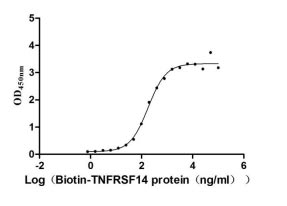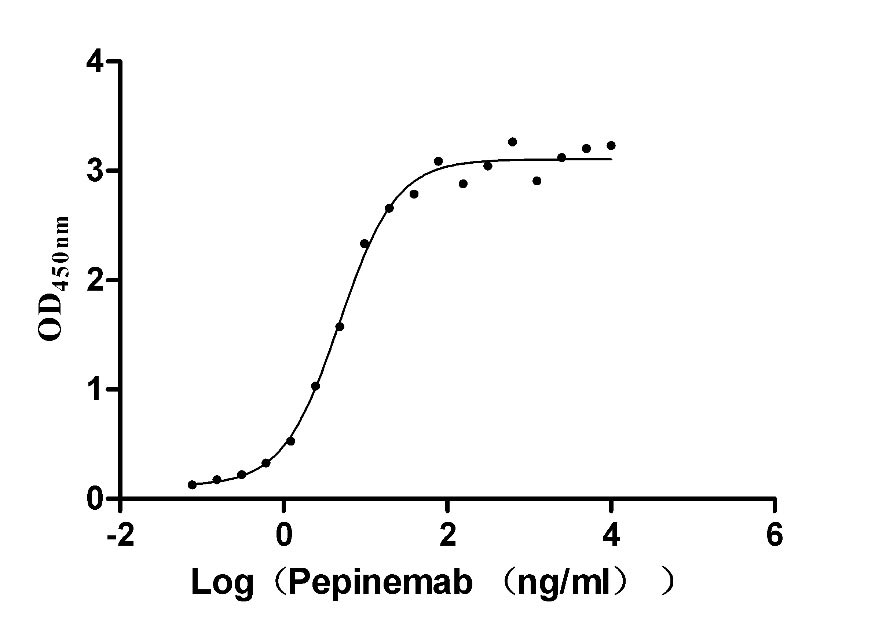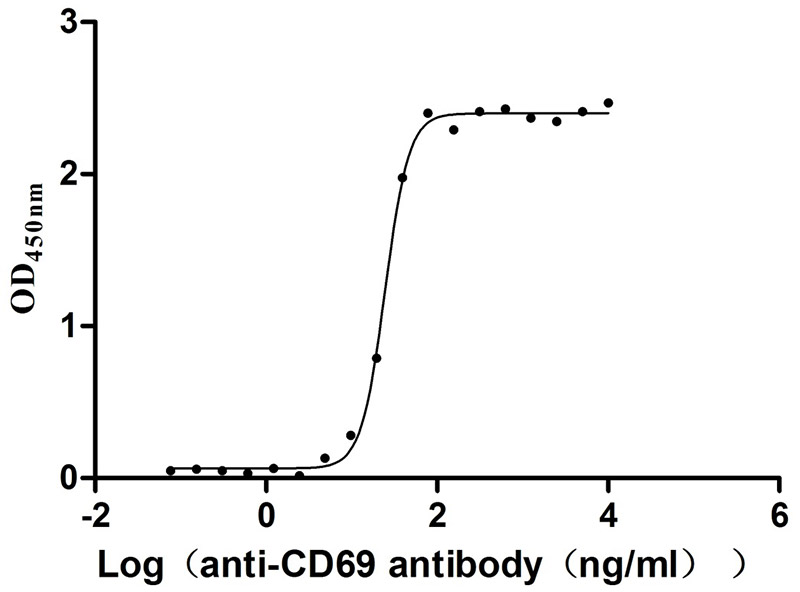Recombinant Mouse Hepatocyte growth factor-like protein (Mst1)
-
中文名称:小鼠Mst1重组蛋白
-
货号:CSB-YP015055MO
-
规格:
-
来源:Yeast
-
其他:
-
中文名称:小鼠Mst1重组蛋白
-
货号:CSB-EP015055MO
-
规格:
-
来源:E.coli
-
其他:
-
中文名称:小鼠Mst1重组蛋白
-
货号:CSB-EP015055MO-B
-
规格:
-
来源:E.coli
-
共轭:Avi-tag Biotinylated
E. coli biotin ligase (BirA) is highly specific in covalently attaching biotin to the 15 amino acid AviTag peptide. This recombinant protein was biotinylated in vivo by AviTag-BirA technology, which method is BriA catalyzes amide linkage between the biotin and the specific lysine of the AviTag.
-
其他:
-
中文名称:小鼠Mst1重组蛋白
-
货号:CSB-BP015055MO
-
规格:
-
来源:Baculovirus
-
其他:
-
中文名称:小鼠Mst1重组蛋白
-
货号:CSB-MP015055MO
-
规格:
-
来源:Mammalian cell
-
其他:
产品详情
-
纯度:>85% (SDS-PAGE)
-
基因名:Mst1
-
Uniprot No.:
-
别名:Mst1; Hgfl; Hepatocyte growth factor-like protein; Macrophage stimulatory protein; MSP) [Cleaved into: Hepatocyte growth factor-like protein alpha chain; Hepatocyte growth factor-like protein beta chain]
-
种属:Mus musculus (Mouse)
-
蛋白长度:Full Length of Mature Protein
-
表达区域:19-716
-
氨基酸序列QR SPLNDFQLFR GTELRNLLHT AVPGPWQEDV ADAEECARRC GPLLDCRAFH YNMSSHGCQL LPWTQHSLHT QLYHSSLCHL FQKKDYVRTC IMDNGVSYRG TVARTAGGLP CQAWSRRFPN DHKYTPTPKN GLEENFCRNP DGDPRGPWCY TTNRSVRFQS CGIKTCREAV CVLCNGEDYR GEVDVTESGR ECQRWDLQHP HSHPFQPEKF LDKDLKDNYC RNPDGSERPW CYTTDPNVER EFCDLPSCGP NLPPTVKGSK SQRRNKGKAL NCFRGKGEDY RGTTNTTSAG VPCQRWDAQS PHQHRFVPEK YACKDLRENF CRNPDGSEAP WCFTSRPGLR MAFCHQIPRC TEELVPEGCY HGSGEQYRGS VSKTRKGVQC QHWSSETPHK PQFTPTSAPQ AGLEANFCRN PDGDSHGPWC YTLDPDILFD YCALQRCDDD QPPSILDPPD QVVFEKCGKR VDKSNKLRVV GGHPGNSPWT VSLRNRQGQH FCGGSLVKEQ WVLTARQCIW SCHEPLTGYE VWLGTINQNP QPGEANLQRV PVAKAVCGPA GSQLVLLKLE RPVILNHHVA LICLPPEQYV VPPGTKCEIA GWGESIGTSN NTVLHVASMN VISNQECNTK YRGHIQESEI CTQGLVVPVG ACEGDYGGPL ACYTHDCWVL QGLIIPNRVC ARPRWPAIFT RVSVFVDWIN KVMQLE
-
蛋白标签:Tag type will be determined during the manufacturing process.
The tag type will be determined during production process. If you have specified tag type, please tell us and we will develop the specified tag preferentially. -
产品提供形式:Lyophilized powder
Note: We will preferentially ship the format that we have in stock, however, if you have any special requirement for the format, please remark your requirement when placing the order, we will prepare according to your demand. -
复溶:We recommend that this vial be briefly centrifuged prior to opening to bring the contents to the bottom. Please reconstitute protein in deionized sterile water to a concentration of 0.1-1.0 mg/mL.We recommend to add 5-50% of glycerol (final concentration) and aliquot for long-term storage at -20℃/-80℃. Our default final concentration of glycerol is 50%. Customers could use it as reference.
-
储存条件:Store at -20°C/-80°C upon receipt, aliquoting is necessary for mutiple use. Avoid repeated freeze-thaw cycles.
-
保质期:The shelf life is related to many factors, storage state, buffer ingredients, storage temperature and the stability of the protein itself.
Generally, the shelf life of liquid form is 6 months at -20°C/-80°C. The shelf life of lyophilized form is 12 months at -20°C/-80°C. -
货期:Delivery time may differ from different purchasing way or location, please kindly consult your local distributors for specific delivery time.Note: All of our proteins are default shipped with normal blue ice packs, if you request to ship with dry ice, please communicate with us in advance and extra fees will be charged.
-
注意事项:Repeated freezing and thawing is not recommended. Store working aliquots at 4°C for up to one week.
-
Datasheet :Please contact us to get it.
靶点详情
-
基因功能参考文献:
- data revealed that OSM alleviated postinfarction cardiac remodeling and dysfunction by enhancing cardiomyocyte autophagy. OSM holds promise as a therapeutic target in treating HF after MI through Obeta receptor by inhibiting Mst1 phosphorylation. PMID: 27825852
- The results identify Mst1 as a malefactor in the development of post-infarction cardiac injury and that it acts through the JNK-Drp1-mitochondrial fission pathway. PMID: 29760744
- The results suggest that melatonin alleviates cardiac remodeling and dysfunction in diabetic cardiomyopathy by upregulating autophagy, limiting apoptosis, and modulating mitochondrial integrity and biogenesis. The mechanisms are associated with Mst1/Sirt3 signaling. PMID: 28480597
- These data suggest that MSP is an effective inhibitor of inflammation and lipid accumulation in the stressed liver, thereby indicating that MSP has a key regulatory role in non-alcoholic steatohepatitis. PMID: 27609031
- kinases, including Slk, Lok and Mst1, are inhibited by BI-D1870 but to a much lesser extent by BIX 02565 and that phosphorylation of some of their substrates is blocked by BI-D1870 in living cells. PMID: 27919044
- Nicorandil alleviates post-MI cardiac dysfunction and remodeling. The mechanisms were associated with enhancing autophagy and inhibiting apoptosis through Mst1 inhibition. PMID: 29127009
- Using a standard two-thirds partial hepatectomy (PH) model in young and aged mice, the activity of the core kinases MST1 and LATS1 increased during the early hypertrophic phase and returned to steady state levels in the proliferative phase, coinciding with activation of YAP1 target genes and hepatocyte proliferation. PMID: 27940445
- The MST1 acts as a molecular brake to maintain immune tolerance by regulating T cell-mediated B cell activation. PMID: 28527887
- Mst1 knockout alleviated while Mst1 overexpression aggravated cardiac dysfunction in diabetes. PMID: 27510910
- these findings highlight a role for MST1 in vesicle trafficking and extravasation in neutrophils, providing an additional mechanistic explanation for the severe immune defect PMID: 27701149
- Results identify L-plastin as a key effector of Mst1 and establish a novel mechanism linking a signaling intermediate to an actin-binding protein critical to T cell migration. PMID: 27465533
- MIST1 is a scaling factor necessary and sufficient by itself to induce and maintain secretory cell architecture PMID: 28174210
- Mst1 deficiency diminishes atherosclerosis and stabilizes atherosclerotic plaques in ApoE(-/-) mice. Mst1 may participate in atherosclerosis progression through inhibition of macrophage autophagy and promotion of macrophage apoptosis. PMID: 27496379
- These results suggest that melatonin alleviates postinfarction cardiac remodeling and dysfunction by upregulating autophagy, decreasing apoptosis, and modulating mitochondrial integrity and biogenesis. The attributed mechanism involved, at least in part, Mst1/Sirt1 signaling PMID: 27696525
- TRAF2 functions as a key activator of MST1 in oxidative stress-induced intracellular signaling processes. PMID: 26698664
- Mst1 regulates hepatic lipid metabolism by inhibiting Sirt1 ubiquitination in mice. PMID: 26903296
- Mst1 enhances Foxp3 expression and Treg function at the post-translational level. PMID: 26538561
- our study demonstrates the existence of a direct crosstalk between mTORC2 and MST1 that is critical for cardiac cell survival and growth. PMID: 25843706
- Mst1 regulates Myosin IIa dynamics to organize high and low affinity LFA-1 to the anterior and posterior membrane during T cell migration. PMID: 25133611
- protein and mRNA expression of the MST1 and LATS2 were decreased significantly as mouse age increased (p < 0.05), however, the mRNA expression of them increased significantly in 16 m compared with 5 m as well as the protein expression of LATS2. PMID: 25659841
- first evidence for HGFL as a positive regulator of mammary gland ductal morphogenesis by controlling overall epithelial cell turnover, macrophage recruitment, and STAT3 activation in the developing mammary gland PMID: 25049204
- Rab13 acts with Mst1 to regulate the spatial distribution of LFA-1 and the motility and trafficking of lymphocytes PMID: 25074980
- report implicates Mst1 as a critical regulator of adaptive immune responses, Th1/Th2-dependent cytokine production, and as a potential therapeutic target for immune disorders PMID: 24852423
- functional consequences of the macrophage stimulating protein 689C inflammatory bowel disease risk allele PMID: 24409221
- results showed that Mst1/Mst2 are required for proper cardiac lineage cell development and teratoma formation. PMID: 24224013
- Mst1 promoted cardiac dysfunction in mice subjected to myocardial infarction by inhibiting autophagy, associated with increased levels of Thr108-phosphorylated Beclin1. PMID: 24141421
- MST1 was found to mediate SOD1(G93A)-induced activation of p38 mitogen-activated protein kinase and caspases as well as impairment of autophagy in spinal cord motoneurons of SOD1(G93A) mice. PMID: 23818595
- Results suggest that Mst1 has a key role in regulating thymocyte self-antigen recognition in the medulla. PMID: 23033074
- findings reveal a tumor suppressive function of Mst1 based on its ability to prevent chromosomal instability in lymphocytes PMID: 22926556
- Mst1 and Mst2 kinases control Rho GTPase activation and the migratory responses of single positive thymocytes. PMID: 22412158
- Both MST1 and Fas death domain-associated protein (Daxx) are key mediators of microglial cell death induced by the proinflammatory cytokine interferon (IFN)-gamma. PMID: 21572393
- Inhibition of TLR4-induced IkappaB kinase activity by the RON receptor tyrosine kinase and its ligand, macrophage-stimulating protein. PMID: 21078906
- tolerance to increased levels of intracellular ROS provided by the Mst1-FoxOs signaling pathway is crucial for the maintenance of naive T cell homeostasis in the periphery PMID: 19956688
- show that Mst1 and Mst2 play redundant roles, and removal of both resulted in early lethality in mouse embryos. PMID: 20080598
- show using a conditional allele of sav1, that an adaptor that potentiates mst1 and mst2 activity is likewise required to suppress growth in the mature liver and to prevent tumor formation. PMID: 20080689
- Data show that Ron mRNA is expressed by nerve growth factor-dependent sensory and sympathetic neurons and that these neurons survive and grow with macrophage stimulating protein (MSP) at different stages of development. PMID: 12538524
- Macrophage-stimulating protein may actively suppress cell-mediated immune responses through its ability to down-regulate IL-12 production and thus inhibit classical activation of macrophages. PMID: 14734766
- RAPL and Mst1 localized to vesicular compartments and dynamically translocated with LFA-1 to the leading edge upon Rap1 activation. PMID: 16892067
- MST1 and MST2 are activated in mitosis and catalyze the mitotic phosphorylation of MOBKL1A/MOBKL1B, which is sufficient to inhibit proliferation through actions at several points in the cell cycle. PMID: 18328708
- Mst1/2-catalyzed MOBKL1A/B phosphorylation slows proliferation and is therefore a likely contributor to the anti-proliferative action of Mst1 in naive T cells PMID: 19073936
- Mst1 is crucial in controlling lymphocyte chemotaxis and thymocyte emigration PMID: 19692642
显示更多
收起更多
-
亚细胞定位:Secreted.
-
蛋白家族:Peptidase S1 family, Plasminogen subfamily
-
组织特异性:Liver. Lower levels in lung, placenta and adrenal.
-
数据库链接:
KEGG: mmu:15235
STRING: 10090.ENSMUSP00000035211
UniGene: Mm.8369
Most popular with customers
-
Recombinant Human B- and T-lymphocyte attenuator (BTLA), partial (Active)
Express system: Mammalian cell
Species: Homo sapiens (Human)
-
Recombinant Human Semaphorin-4D (SEMA4D), partial (Active)
Express system: Mammalian cell
Species: Homo sapiens (Human)
-
Recombinant Dog Angiopoietin-2 (ANGPT2) (Active)
Express system: Mammalian cell
Species: Canis lupus familiaris (Dog) (Canis familiaris)
-
Recombinant Human Microtubule-associated protein tau (MAPT) (Active)
Express system: Mammalian cell
Species: Homo sapiens (Human)
-
Recombinant Human Lymphocyte antigen 6 complex locus protein G6d (LY6G6D) (Active)
Express system: Yeast
Species: Homo sapiens (Human)
-
Recombinant Human Early activation antigen CD69 (CD69), partial (Active)
Express system: Mammalian cell
Species: Homo sapiens (Human)





-AC1.jpg)












